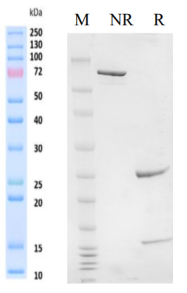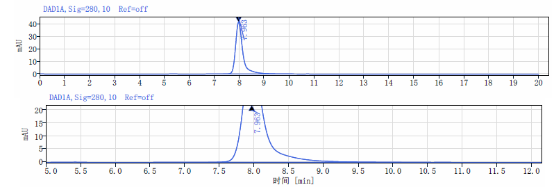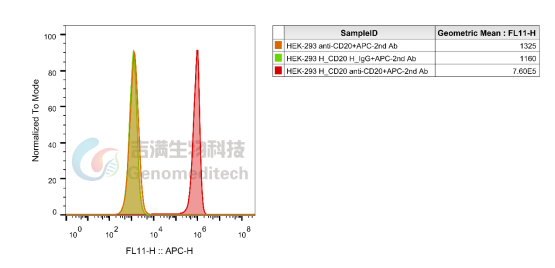Cat. No:GM-87804MAB
Product:Anti-CD20 hIgG1 Reference Antibody (Ritubio)
Cat. No:GM-87804MAB
Product:Anti-CD20 hIgG1 Reference Antibody (Ritubio)
GM-87804MAB-1mg / 1 mg
GM-87804MAB-5mg / 5 mg
GM-87804MAB-25mg / 5 mg*5vials
GM-87804MAB-50mg / 50 mg
GM-87804MAB-100mg / 50 mg*2vials
Expression System | CHO |
Aggregation | < 5% as determined by SEC-HPLC |
Purity | > 95% as determined by SDS-PAGE |
Endotoxin | < 1 EU/mg, determined by LAL gel clotting assay |
Sterility | 0.2 μm Filtered |
Target | CD20 |
Clone | Rituximab |
Alternative Names | B1, Bp35, CVID5, FMC7, LEU-16, S7 |
Source/Isotype | Human IgG19 (KDEL), Kappa |
Application | Flow cytometry |
Description | B-lymphocyte antigen CD20 or CD20 is expressed on the surface of all B-cells beginning at the pro-B phase (CD45R+, CD117+) and progressively increasing in concentration until maturity. In humans CD20 is encoded by the MS4A1 gene. This gene encodes a member of the membrane-spanning 4A gene family. Members of this nascent protein family are characterized by common structural features and similar intron/exon splice boundaries and display unique expression patterns among hematopoietic cells and nonlymphoid tissues. This gene encodes a B-lymphocyte surface molecule that plays a role in the development and differentiation of B-cells into plasma cells. Immunohistochemistry can be used to determine the presence of CD20 on cells in histological tissue sections. Because CD20 remains present on the cells of most B-cell neoplasms,and is absent on otherwise similar appearing T-cell neoplasms, it can be very useful in diagnosing conditions such as B-cell lymphomas and leukaemias. However, the presence or absence of CD20 in such tumours is not relevant to prognosis, with the progression of the disease being much the same in either case. CD20 positive cells are also sometimes found in cases of Hodgkins disease, myeloma, and thymoma. |
Formulation | phosphate-buffered solution, pH 7.2-7.4. |



Cat. No:GM-87804MAB
Product:Anti-CD20 hIgG1 Reference Antibody (Ritubio)
GM-87804MAB-1mg / 1 mg
GM-87804MAB-5mg / 5 mg
GM-87804MAB-25mg / 5 mg*5vials
GM-87804MAB-50mg / 50 mg
GM-87804MAB-100mg / 50 mg*2vials
Expression System | CHO |
Aggregation | < 5% as determined by SEC-HPLC |
Purity | > 95% as determined by SDS-PAGE |
Endotoxin | < 1 EU/mg, determined by LAL gel clotting assay |
Sterility | 0.2 μm Filtered |
Target | CD20 |
Clone | Rituximab |
Alternative Names | B1, Bp35, CVID5, FMC7, LEU-16, S7 |
Source/Isotype | Human IgG19 (KDEL), Kappa |
Application | Flow cytometry |
Description | B-lymphocyte antigen CD20 or CD20 is expressed on the surface of all B-cells beginning at the pro-B phase (CD45R+, CD117+) and progressively increasing in concentration until maturity. In humans CD20 is encoded by the MS4A1 gene. This gene encodes a member of the membrane-spanning 4A gene family. Members of this nascent protein family are characterized by common structural features and similar intron/exon splice boundaries and display unique expression patterns among hematopoietic cells and nonlymphoid tissues. This gene encodes a B-lymphocyte surface molecule that plays a role in the development and differentiation of B-cells into plasma cells. Immunohistochemistry can be used to determine the presence of CD20 on cells in histological tissue sections. Because CD20 remains present on the cells of most B-cell neoplasms,and is absent on otherwise similar appearing T-cell neoplasms, it can be very useful in diagnosing conditions such as B-cell lymphomas and leukaemias. However, the presence or absence of CD20 in such tumours is not relevant to prognosis, with the progression of the disease being much the same in either case. CD20 positive cells are also sometimes found in cases of Hodgkins disease, myeloma, and thymoma. |
Formulation | phosphate-buffered solution, pH 7.2-7.4. |


